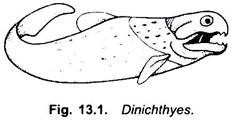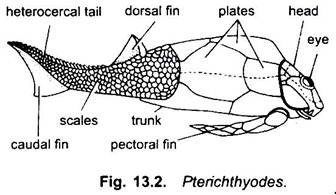In this article we will discuss about:- 1. Occurrence of Placodermi 2. Features of Placodermi 3. Classification 4. Biological Significance.
Occurrence of Placodermi:
In the Silurian, some 450 million years ago, as the ostracoderms were disappearing, a host of more efficient and jawed fishes appeared. Earlier grouped in a single category, they are now placed into two separate classes- Placodermi and Acanthodii. According to taxonomists, these classes are placed lower to Chondrichthyes in the evolutionary scale.
Acanthodians were freshwater, superficially shark-like fishes. Usually they had elongated fusiform bodies almost eel-like. Their bodies were covered by diamond-shaped scales. A common fossil genus Climatius was about 8 cm long. Between larger pectoral and pelvic fins, they had extra smaller paired fins some of which in the form of stout spines, hence, the name ‘spiny shark’. Some of them had true teeth, especially on the lower jaw. The acanthodians survived into earlier Permian before they became extinct.
Placodermi were the earliest jawed vertebrates of fossil record. They appeared in Silurian, flourished in Devonian and Carboniferous and became extinct in Permian. They probably lived both in freshwater as well as sea water. Some primitive agnath ostracoderms were probably the ancestors of placoderms.
ADVERTISEMENTS:
But their fossil record does not exhibit any connecting link between the jawless and jawed fishes. Like the ostracoderms, the jawed fishes also appear fully formed without intermediates. Fossil evidence for ancestry of placodermi simply does not exist.
Features of Placodermi:
The placoderms possess the heavy defensive armour of bony plates with powerful jaws and efficient fins.
1. Bony Armour:
The name placodermi means ‘armoured fish’ or ‘plate skinned’ (Gr., plakos = plates; derma = skin). The dermal armour of placodermi links them genetically with their predecessors, the osteoderms. The placoderms were highly diversified. They were ranging in length from a few centimeters to three meters or more.
ADVERTISEMENTS:
The giant predator, Dunkleosteus, grew to ten meters. Despite the differences among them, all were characterised by the presence of a bony skeleton. Some in particular Dunkleosteus exhibited a heavy armour of bony plates over the head and anterior part of trunk, while the rest of the body was nearly naked.
2. Jaws:
All placoderms possess jaws. The jaws are supposed to have originated from the first pair of gill- bars (mandibular arch) in front of the first gill-slit. Hyoid gill-arch persisted and as a result of which spiracles had not arisen. Hyoid arch remained unmodified and did not support the jaws. This type of primitive jaw suspension called aphetohyoidean type.
The placoderm jaw is autostylic, i.e., it is articulated by its own processes to the cranium. No placoderms ever developed teeth of a modem type as did the acanthodians. The jaws of placoderms were immovably bound to cranium or rest of the head. These handicaps may have been involved in their eventual extinction.
ADVERTISEMENTS:
3. Paired Fins:
Most placoderms possess paired fins. These are essentially adaptive organs. In an aquatic environment, development of strong mobile fins was coincident with the evolution of jaws, for swimming faster. The lateral fins served to produce turning movements in any direction (right, left, up or down) and to prevent roll, pitch and yaw when swimming in a straight path.
Placoderms survived for short period only and are often considered as ‘unsuccessful ancient experiment’ in the evolution of gnathostomes.
Classification of Placodermi:
Various schemes of classification have been forwarded by different workers. Berg (1940) and Romer (1959) forwarded detailed classification of fishes, which have been generally accepted. A new scheme of classification, often called modem classification of fishes, have been forwarded by Bertin and Armbourg (1958) and Greenwood et.al., (1989).
All the extinct earliest jawed fishes were once believed to be generally related and, therefore, placed in a single group or class, the Placodermi. But the spiny sharks are now placed in a separate class Acanthotii. Two groups, subclasses or orders of class Placodermi are generally recognised.
These are:
1. Arthrodiriformes and
2. Antiarchiformes.
Order 1. Arthrodiriformes:
ADVERTISEMENTS:
This group flourished in the Devonian. Earliest placoderms. Resembled with ostracoderms in appearance and habitat. Heavy bony armour, shields of head and trunk meeting in a movable joint (Gr., arthros = joint). Powerful gaping jaws with sharp shearing blades. Violently predaceous.
Example- Dunkleosteus, Coccosteus, Dinichthyes (Fig. 13.1).
Order 2. Antiarchiformes:
This group was confined to the Devonian period. Bottom-dwellers and mud-feeders in freshwater. Head and fore part of trunk was covered by a depressed bony shield. These cephalic plates had a different arrangement and the mode of attachment of head with body shield was also different. Pectoral fins long.
Example- Bothriolepes, Pterichthyodes (=Pterichthys) (Fig. 13.2).
Biological Significance Placodermi:
Placoderms were the earliest of the known fossil jawed vertebrates. They appeared in the Silurian, flourished in the Devonian and Carboniferous and became extinct in the Permian. Their bony armour links them genetically with their predecessors, the ostracoderms. Due to the presence of bony jaws and paired fins, they were more specialised than ostracoderms. A new era in the history of fishes started with the advent of jaws.
Prof A.S. Romer in his book ‘The Vertebrate Body’ recalls that Perhaps the greatest of all advances in vertebrate history was the development of jaws and the consequently revolution in the mode of life of early fishes.
There exists no fossil evidence for the ancestry of placoderms. Some primitive ostracoderms were probably their ancestors. According to one view, the placoderms all became extinct by the end of Palaeozoic era, without giving rise to any surviving forms.
According to another view, the cartilaginous fishes or Chondrichthyes and the bony fishes or Osteichthyes, both arose in the early Devonian from some primitive group of placoderms. Contrary to the former belief, the cartilaginous fishes did not give rise to the bony fishes. Thus bone, rather than cartilage, is to be considered a primitive characteristic.

